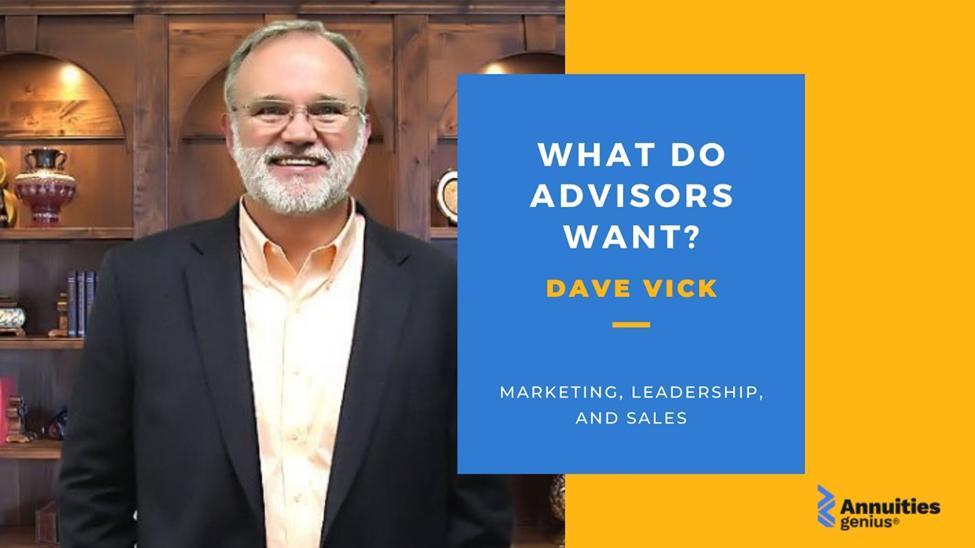What Do Financial Advisors Want?

Which Financial Advisors are we talking about?
They all will look different of course. A tour through LinkedIn will give you an idea of the diversity in our business. They come in all types. Men and women. Individuals and teams. Captive and independent. RIAs, BDs, Insurance, and alternatives. All with differing points of view, serving anyone from millennials to gen-xers to boomers to seniors. Not to mention those serving primarily women, families, ethnic groups, or people groups. Or those serving the marginalized to middle class to high net worth. I don’t even want to touch the subject of politics and varied religious beliefs that abound in all the work force we call home. Even after all those considerations, I am quite sure I have not hit everyone.
What a business we’re in!
So, what do all advisors really want?
For sure, Advisors need a good vision and mission to aim them in the right direction. But, to get what they want, they must simply manage their needs in three areas: Marketing, Sales Process, and Service. These needs are the same for everyone. Everyone needs to communicate effectively to the target audience that they envisioned, giving them highly qualified prospects with a high probability for success. They need a sales process (I hate the term) that will end in the best benefit for the client, regardless of the commission or fees. And finally, but not in any way of least importance, we have the need for clients to be serviced in such a way that it creates Raving Fans (see Ken Blanchard’s book by the same name).
I don’t have enough room in this context for a detailed discussion of all three, so let’s take a quick look to see if you are getting what you need.
- To direct on a course or in a direction
- To go at the head of
- To bring to some conclusion or condition
I hope you can see the difference and would long to be the kind of advisor that would “think with, not for” a client, leading them to the best financial decision for them. It takes a little more skill and a fewer clever closing techniques. You choose.
Once you decide to be a leader you can adopt a process that fits your style of leadership. Let me suggest one that has worked for me and hundreds of others. Discover, Design, Deploy. It’s simple and clear. Let me explain each one.
Discovery is the beginning phase of the journey to a great decision for your prospect. You will want to find out about your prospect and let them find out about you. Yes, that means you need to not only know their financial picture, but you need to know who they are personally and what they desire. How do they make decisions? What are their fears regarding financial planning? What are their dreams and limits? They need to know you and your process. Are they comfortable with both? Discovery is an exciting relationship building phase that carries you into the next phase.
Design usually comes in two phases: analysis and architecture. Analysis is simply taking their assets and giving them and yourself a clear picture of what they have as it applies to their desires. It includes risk, cost, fees, liquidity, safety, and so much more. This is where good software comes in. To analyze something in detail you need to have both a complete, detailed knowledge of their current finances and a clear presentation of such that they can understand. The second part of the Design phase, architecture, is just what it sounds like: thinking with them through building the financial house of their future. Most advisors go behind the green curtain and build a plan which they then present to the client. I suggest you develop a style of thinking with the client through the plan options. Let them choose options of risk, cost, safety, liquidity, and such. They will be much more apt to follow your leadership if you include them in the process. Most of us don’t trust leaders who simply tell us what to do without any reasoning.
This is where Annuities Genius can be of such great value. When it comes to conservative investors, which 70% of Americans say they are, then this software can give them what they want in an easy to understand format. What is better is that it is easy to learn as well as being the most thorough annuity case builder in the business. Give it a “look see” and you will get hooked. Yes, there is a cost, but if it helps lead a client to putting just $30,000 more in a product that fits their conservative nature (an annuity) you, will have paid for your subscription. Come on now! That’s amazing!
Last phase in the Leadership Process is the Deployment phase. This is not just a delivery of an annuity or a statement review. Yes, it is all of that, but it can be so much more. This is the launch pad for the relationship you will have for many years with these folks. They have decided to follow you! Do not just deploy a plan. Be a partner with them. Schedule their next review right now. Tell them how communication in your office works, who to go to for what they need, when your client reviews are, and invite them to your next client event. Explain the valued communication you will be sending them digitally. And most of all, invite them to be a “client partner” not just a client.
Let me explain.
Marketing – it all starts here!
As I said, every advisor needs to communicate effectively to the target audience they envision, giving them highly qualified prospects with a high probability for success. I am reminded of a conversation I have had recently with a group doing online marketing for advisors. They said that advisors should not confuse marketing with sales. While I agree, I think that marketing done well should give you, not just a lead, but a highly qualified lead, setting you up for success in your office or virtually. To put it simply: advisors need highly qualified prospects and a high probability for success.
First, a highly qualified lead is a person or couple that fits your ideal client profile of age, assets, income, temperament, activity in community, profession, etc. You must have a specific bulls’ eye for a target client to know when you have struck the center of your wish list.
Second, you need a prospect that has shown interest in what you have to offer and in you personally. They have asked for your time. They have taken the step to research you and now wish to see if you can help them. They know what to expect when they see you and the process you will lead them through. That is a highly qualified lead with a high probability for success. If your “lead” is not at that point yet, all you have is a cold lead and not a prospect. You are still in the marketing stage of the process.
Notice I said that the prospect must be aware of you, what you offer and your process for them to move forward. This enables the second phase of a practice to be successful. The sales process. Now I hate that term, so let’s agree right now to call it a Leadership Process.
The Leadership Process: The artist previously known as Sales Process
I have come to call the sales process a leadership process simply because that is what it could and probably should be. It has been said that everyone wants to buy but nobody wants to be sold. You know it’s true. If you look up the word “SELL” in Webster’s Dictionary you will find these kinds of comments:
To Sell
- To deliver or give up in violation of duty, trust, or loyalty and especially for personal gain: BETRAY – often used with “out”; sell out their country.
- To give up in return for something else especially foolishly or dishonorably - sold his birthright for a mess of pottage
- To deliver into slavery for money
- To give into the power of another – sold His soul to the devil
- To dispose of or manage for profit instead of in accordance with conscience, justice, or duty - sold their votes
- To impose on: CHEAT
I think you get the point. I do not want to say that if you sell something all the above apply to you. I simply want to point out that those you are selling often see you in the light of what is stated above. They do not like salespeople. Do not like to be sold. It is just part of our culture. If you appear in any way to try to sell them something you are swimming against the current.
However, look at the word “LEAD” in Webster’s and you will find comments like these:
- To guide on a way especially by going in advance
A client partner is somebody who commits to bring others to your client events or even a simple lunch or dinner with you with the purpose of seeing if you are the kind of person their friend might want to do business with. Studies show that people want to refer you. They hate to get asked to do so; however, they want to validate the decision to work with you by seeing if their friend or friends will do the same. Providing them with opportunities to succeed as a client partner will expand your business and your enjoyment.
Client events do not have to be glamorous and spectacular. They can be exceedingly simple. They provide an opportunity for your client partners to introduce you to their friends. You want to have something to invite somebody to on a regular basis, letting your clients in on the schedule. That’s all.
The leadership process takes an ongoing development of communication and people skills that can be helped greatly by coaching. This is an area of expertise that you can improve on dramatically over time. Most “salespeople” in America close about 20% or less of their actual opportunities. I have seen it grow in those who are teachable to as high as 60% and higher. As you can see, this triples your business. People who say they close at 100% are simply…well, I won’t put it in print, but obviously stay away from the “salesy” pitch. Coaching is valuable here and worth the expense if you are teachable.
Service: It is the long-term solution
As I mentioned above, I have much more expertise in marketing and leadership process than I do in service. However, I believe that the longevity of your business does not necessarily depend on clever marketing or exceptional sales techniques. In the end, your commitment to serve people will determine the long-term sustainability of your practice.
Building a good service platform comes in stages, depending on the acquisition of new clients and even the anticipation of such. Remember this: You only make money when you are in front of prospects and clients. Everything else must eventually be done by someone else in order for your business to grow and thrive.
You will probably want to hire people to cover client communications, events coordinator, marketing, financial analysis, leadership meetings, and more. If you have the philosophy of hiring “good people” and empowering them to make great decisions, you will not be caught in the trap of micro-management.
In the end, what advisors really want is simple: highly qualified prospects with a high probability of success over the long term. It sounds simple, yet requires an ongoing sophistication that can be challenging, exciting and exceedingly rewarding both financially and personally.

